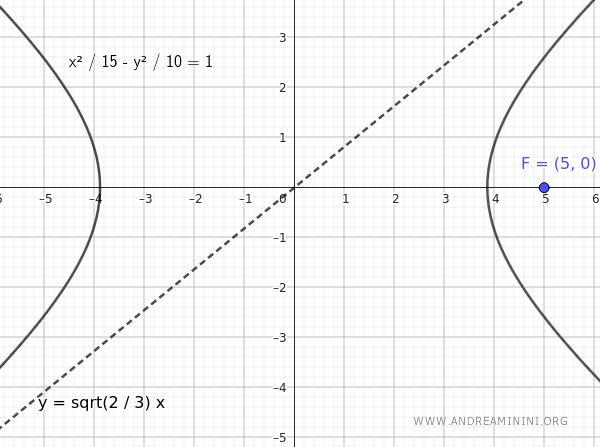Finding the Equation of a Hyperbola Given an Asymptote and a Focus
To find the equation of a hyperbola centered at the origin, knowing the location of a focus helps determine whether the transverse axis lies along the x-axis or the y-axis.
- If the focus is at $ F(c;0) $, the transverse axis is the x-axis, and the equation of the hyperbola is $$ \frac{x^2}{a^2} - \frac{y^2}{b^2} = 1 $$
- If the focus is at $ F(0;c) $, the transverse axis is the y-axis, and the equation of the hyperbola becomes $$ \frac{x^2}{a^2} - \frac{y^2}{b^2} = -1 $$
In either case, the equations for the asymptotes of the hyperbola are:
$$ y = \pm \frac{b}{a} x $$
The relationship between the semi-axes $ a $ and $ b $ and the distance $ c $ from the center to the focus is always:
$$ c^2 = a^2 + b^2 $$
With these elements, you can determine the equation of the hyperbola.
A Practical Example
Let’s consider a hyperbola with a focus at
$$ F(c;0) = F(5;0) $$
and an asymptote given by
$$ y = \sqrt{\frac{2}{3}} x $$
Since the focus is on the x-axis, the equation of the hyperbola is:
$$ \frac{x^2}{a^2} - \frac{y^2}{b^2} = 1 $$
To find the semi-axes $ a $ and $ b $, we use a system of equations involving the asymptote equation and the relationship between the semi-axes.
$$ \begin{cases} y = \pm \frac{b}{a} x \\ \\ c^2 = a^2 + b^2 \end{cases} $$
We know the equation of the asymptote $ y = \sqrt{\frac{2}{3}} x $ and the distance from the center to the focus, $ c = 5 $.
$$ \begin{cases} \sqrt{\frac{2}{3}} x = \frac{b}{a} x \\ \\ 5^2 = a^2 + b^2 \end{cases} $$
Dividing both sides of the first equation by $ x $, we get:
$$ \begin{cases} \sqrt{\frac{2}{3}} = \frac{b}{a} \\ \\ 25 = a^2 + b^2 \end{cases} $$
We can now solve for $ b $ in the first equation:
$$ \begin{cases} b = \sqrt{\frac{2}{3}} a \\ \\ 25 = a^2 + b^2 \end{cases} $$
Substituting $ b $ into the second equation gives:
$$ \begin{cases} b = \sqrt{\frac{2}{3}} a \\ \\ 25 = a^2 + \left(\sqrt{\frac{2}{3}} a\right)^2 \end{cases} $$
$$ \begin{cases} b = \sqrt{\frac{2}{3}} a \\ \\ 25 = a^2 + \frac{2}{3} a^2 \end{cases} $$
$$ \begin{cases} b = \sqrt{\frac{2}{3}} a \\ \\ 25 = \frac{5a^2}{3} \end{cases} $$
$$ \begin{cases} b = \sqrt{\frac{2}{3}} a \\ \\ a^2 = 25 \cdot \frac{3}{5} \end{cases} $$
$$ \begin{cases} b = \sqrt{\frac{2}{3}} a \\ \\ a^2 = 15 \end{cases} $$
$$ \begin{cases} b = \sqrt{\frac{2}{3}} a \\ \\ a = \sqrt{15} \end{cases} $$
Once we have $ a = \sqrt{15} $, we can substitute it back into the first equation to find $ b $:
$$ \begin{cases} b = \sqrt{\frac{2}{3}} \sqrt{15} \\ \\ a = \sqrt{15} \end{cases} $$
$$ \begin{cases} b = \sqrt{\frac{2}{3} \cdot 15} \\ \\ a = \sqrt{15} \end{cases} $$
$$ \begin{cases} b = \sqrt{10} \\ \\ a = \sqrt{15} \end{cases} $$
So, the lengths of the semi-axes are $ a = \sqrt{15} $ and $ b = \sqrt{10} $, which can be substituted into the standard equation of the hyperbola.
$$ \frac{x^2}{(\sqrt{15})^2} - \frac{y^2}{(\sqrt{10})^2} = 1 $$
$$ \frac{x^2}{15} - \frac{y^2}{10} = 1 $$
This is the equation of the hyperbola with a focus at $ F(c;0) = F(5;0) $ and an asymptote $ y = \sqrt{\frac{2}{3}} x $.

And that's how you derive the equation.
